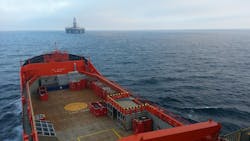Steadily aging vessels driving an increase in offshore incidents
By Truls Richardsen, DNV
The offshore industry operates in some of the most demanding and high-risk environments in the maritime world. Whether supporting deepwater drilling, production, subsea construction or platform supply, offshore units and vessels must meet rigorous safety and performance standards. Yet many of the challenges facing the broader maritime fleet—aging assets, evolving technologies and emerging risks—are just as relevant offshore.
Modern vessel technology is advancing rapidly, with smarter hulls, advanced fire systems and sophisticated navigation tools that enhance safety. But many vessels still in operation were built to older standards and are now aging beyond their intended lifespans, which is raising concerns about structural fatigue, outdated systems and limited compatibility with today’s safety technologies.
At the same time, autonomy and remote operations are gaining ground, promising greater efficiency and control. The IMO’s upcoming Maritime Autonomous Ships and Shipping (MASS) Code will provide a regulatory framework for these emerging capabilities. As innovation accelerates, regulation must keep pace to ensure these systems are at least as safe as conventional vessels.
And with greater connectivity comes greater vulnerability. As vessels become more integrated into digital networks, the risk of cyberattacks increases. Cybersecurity must take its place alongside traditional safety measures and be embedded from the earliest design stages through to day-to-day operations to ensure vessels remain resilient in an increasingly connected maritime world.
With these and other trends in mind, DNV conducted an analysis of Lloyd’s List Intelligence casualty data, and the results were released in the new "Maritime Safety Trends 2014-2024 - Preparing for future risks" report. While drawn from the global cargo and passenger fleets, the results of the analysis hold lessons for the offshore energy world as well.
Casualties on the rise
The number of maritime casualties rose by 15% in 2024. Coupled with a 7% rise in casualties in 2023, this represents a concerning development for the maritime industry, particularly with the global fleet growing at a considerably slower rate.
This trend has now been established for several years. While the overall number of incidents declined by 5% between 2014 and 2018, the figure has increased every year since.
Longer lifespans result in more incidents
The data shows that some 52% of all casualties in 2024 came from vessels that were 20 years old or above, a significant increase from 10 years ago (43%).
Machinery damage or failure has traditionally accounted for the largest portion of incidents. However, its share has increased significantly over the course of the past decade. In 2014, this accounted for 38% of all incidents but rose to 60% by 2024.
Machinery damage/failure is also the main driver of the sharp uptick in casualty numbers in 2024, accounting for 80% of incident growth. For machinery damage/failures, age is a big factor. In 2024, a total of 45% of these came from vessels more than 25 years of age, with another 12% in the 20 to 24 age category. In 2014, the corresponding figures were 39% and 9%, respectively.
Urgent need for better fire safety
The maritime industry is in the middle of a period of great transformation. While this offers significant promise, it is also full of uncertainty, and stakeholders across the industry should continue to adopt best practices in ensuring the safety of vessels and crew.
Better tech helps accident stats
Although the number of "accident" casualties (e.g., a combination of collisions with another vessel, contact with a static object, foundering, and wrecked/stranded) slightly increased in 2024, the overall trend shows that this decreased from a total of 881 in 2014 to 656 in 2024, representing a decline of 26%.
This decline is likely attributable to technological advancements that have seen significant improvements to navigation systems, digital safety mechanisms, and route and weather planning over the past decade. Other factors, such as improved vessel design and engineering, stricter safety regulations, and data-driven risk management, have also contributed.
So, while there are some glimmers of positivity, the overall trend in maritime safety is unmistakably negative. A steadily aging fleet is clearly driving an increase in the number of incidents, and it is incumbent on shipowners to mitigate this issue through better maintenance, or other means.
The industry must act decisively to improve safety standards amid an aging fleet. This includes upgrading fire suppression systems, enforcing stricter maintenance, boosting seafarer training and ensuring regulatory compliance.
About the Author

Truls Richardsen
Truls Richardsen, a master of science in naval architecture, currently serves as the regional offshore manager for DNV Maritime in North America. He oversees offshore classification services from Suriname to the Arctic, encompassing various offshore sectors, including traditional oil and gas, renewables, offshore floating infrastructure, and marine aquaculture. He is a key advocate for Digital Transformation in Offshore Classification, driving efficiency through innovative digital solutions.
Richardsen’s expertise spans over a decade, specializing in fleet in-service and asset integrity management. He is widely recognized for his commitment to innovation and operational efficiency in the offshore industry, complemented by his leadership skills honed during his service as an Army officer in the Norwegian Army.
